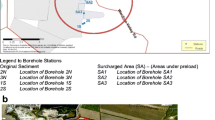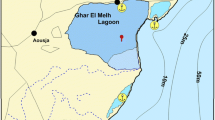Abstract
Trace metals occur at various concentrations in all wetlands. Their proliferation, chemical speciation, mobility and bioavailability are dependent on the redox potential (Eh), pH and the presence of organic and inorganic adsorption surfaces and co-precipitating metals. Consequently, changes in these key parameters have the potential to alter the fate of the dominant trace metal species in the sediment. An imposition of preload surcharge is a technique use in geotechnical engineering to improve in the strength and load carrying capacity of waterlogged sediments. The soil strength improvement is effected through the expulsion of porewater from the sediment. The imposition of surcharge over wetland sediments has the potential to create oxygen-deficient condition within the sediment, and cause pH, temperature, redox, EC and salinity changes in the sediment, which would impact on the mobilisation, chemical speciation, mobility and bioavailability of dominant toxic trace metals and their toxicity in the sediment. In the present work, a case study of the impact of preload surcharge on the proliferation, chemical speciation, mobilisation, mobility and bioavailability of arsenic, chromium, cobalt, copper and zinc in a naturally occurring pyrite-rich sediment is presented. The imposition of preload surcharge over the pyrite-rich sediment was accompanied by changes in the redox dynamics of the sediment, with multi-facet impact on the concentration, mobilisation and bioavailability of toxic trace metals, their redox transformation between oxidation states and on the toxicity within and outside the sediment environment.










Similar content being viewed by others
References
Acharyya, S. K., & Shah, B. A. (2006). Arsenic-contaminated groundwater from parts of Damodar fan-delta and west of Bhagirathi River, West Bengal, India: influence of fluvial geomorphology and quaternary morphostratigraphy. Environmental Geology, 52, 489–501.
Amery, F., Degryse, F., Cheyns, K., De Troyer, I., Mertens, J., Merckx, R., & Smolders, E. (2008). The UV- absorbance of dissolved organic matter predicts the fivefold variation in its affinity for mobilizing Cu in an agricultural soil horizon. European Journal of Soil Science, 59, 1087–1095.
Burton, E. D., Bush, R. T., Johnston, S. G., Watling, K. M., Hocking, R. K., Sullivan, L. A., & Parker, G. K. (2009). Sorption of arsenic by iron-oxides and oxyhydroxides in soils. Environmental Science Technology, 43, 9202–9207.
Chowdhury, S. A., Yanful, E. K., & Pratt, A. R. (2011). Arsenic removal from aqueous solutions by mixed magnetite-maghemite nanoparticles. Environmental Earth Science, 64, 411–423.
Clesceri, L. S., Greenberg, A. E. & Eaton, A. D. (eds.) 1998. Standard Methods for the Examination of Water and Wastewater. APHA, AWWA, WEF.
Fendorf, S. E. (1995). Surface reactions of chromium in soils and waters. Geoderman, 67, 55–71.
Gál, J., Hursthouse, A., Tatner, P., Stewart, F., & Welton, R. (2008). Cobalt and secondary poisoning in the terrestrial food chain: data review and research gaps to support risk assessment. Environment International, 34, 821–838.
Hughes, M., & Poole, R. (1991). Metal speciation and microbial growth-the hard (and soft) facts. Journal of General Microbiology, 137, 725–734.
Jacquat, O., Voegelin, A., & Kretzschmar, R. (2009a). Local coordination of Zn in hydroxy-interlayered minerals and implications for Zn retention in soils. Geochimica et Cosmochim. Acta, 73, 348–363.
Jacquat, O., Voegelin, A., & Kretzschmar, R. (2009b). Soil properties controlling Zn speciation and fractionation in contaminated soils. Geochimica et Cosmochim. Acta, 73, 5256–5272.
Johnson, S. J. (1970). Foundation precompression with vertical sand drains. Journal of the Soil Mechanics and Foundations Division: American Society of Civil Engineers, 96, 145–174.
Karikari-Yeboah, O., & Addai-Mensah, J. (2017). Assessing the impact of preload on pyrite-rich sediment and groundwater quality. Environmental Monitoring and Assessment, 189, 58.
Karikari-Yeboah, O. & Gyasi-Agyei, Y. (2000). Stability of slopes characterised by colluvium: investigation, analysis and stability. GeoEng2000. Melbourne, Australia.
Karikari-Yeboah, O., Skinner, W. & Addai-Mensah, J. (2016). The behaviour of reactive toxic solutes in naturally occurring pyrite-rich sediment under surface surcharge. Chemeca Adelaide, Australia.
Keon, N. E., Swartz, C. H., Brabander, D. J., Harvey, C., & Hemond, H. F. (2001). Validation of an arsenic sequential extraction method for evaluating mobility in sediments. Environmental Science & Technology, 35, 2778–2784.
Kotas, J., & Stasicka, Z. (2000). Chromium occurrence in the environment and methods of its speciation. Environmental Pollution, 107, 263–283.
Lengke, M. F., Sandawanitchakit, C., & Tempel, R. N. (2009). The oxidation and dissolution of arsenic-bearing sulfides. The Canadian Mineralogist, 47, 593–613.
Li, P., Qian, H., & Wu, J. (2014). Accelerated research on land creation. Nature, 510, 29–31.
Mclaren, R. G., & Crawford, D. V. (1973). Studies in soil copper. 1. Fractionation of copper in soils. Journal of Soil Science, 24, 172–181.
Mertens, J., & Smolders, E. (2013). Zinc. In B. J. Alloway (Ed.), Heavy metals in soils—trace metals and matalloids in soils and their bioavailability. Dordrecht: Springer.
Miller, S. D., Robertson, A., & Donohue, T. (1997). Advances in acid drainage prediction using the net acid generation (NAG) test. In: Proceedings of the Fourth International Conference on Acid Rock Drainage, Vancouver, pp. 535–549.
Muller, B., Axelsson, M. A., & Ohlander, B. (2002). Adsorption of trace elements on pyrite surfaces in sukfidic mine tailings from Krisineberg (Sweden) a few years after remediation. The Science of the Total Environment, 298, 1–16.
Nagpal, N. K. 2004. Water quality guidelines for cobalt. . In: Water Protection Section, W., Air And Climate Change Branch, Victoria; BC (ed.). BC, Canada.
Oorts, K. (2013). Copper. In B. J. Alloway (Ed.), Heavy metals in soils—trace metals and metalloids in soils and their bioavailability. London: Springer.
Richard, F. C., & Bourg, A. C. M. (1991). Aqueous geochemistry of chromium: A review. Water Research, 25, 807–816.
Stewart, W. A., Miller, S. D. & Smart, R. 2006. Advances in acid rock drainage (ARD) characterisation of mine wastes. In: (ED.), R. I. B. (ed.) 7th international conference on acid rock drainage (ICARD) St. Louis MO, 2006, 2098, 2119.
Sullivan, L. A., & Bush, R. T. (1997). Quantitative microanalysis of rough soil surface in the scanning electron microscope using peak-to-background method. Soil Science, 162, 749–757.
WHO (ed.) 2001. Environmental health criteria for arsenic and arsenic compounds—EHC 224, Geneva.
Funding
This research was founded by the Maiden Geotechnics and Australian Commonwealth Scholarship awarded by the University of South Australia to the first author.
Author information
Authors and Affiliations
Corresponding author
Ethics declarations
Conflict of interest
The authors declare that they have no conflict of interest.
Rights and permissions
About this article
Cite this article
Karikari-Yeboah, O., Skinner, W. & Addai-Mensah, J. The impact of preload on the mobilisation of multivalent trace metals in pyrite-rich sediment. Environ Monit Assess 190, 398 (2018). https://doi.org/10.1007/s10661-018-6744-x
Received:
Accepted:
Published:
DOI: https://doi.org/10.1007/s10661-018-6744-x




